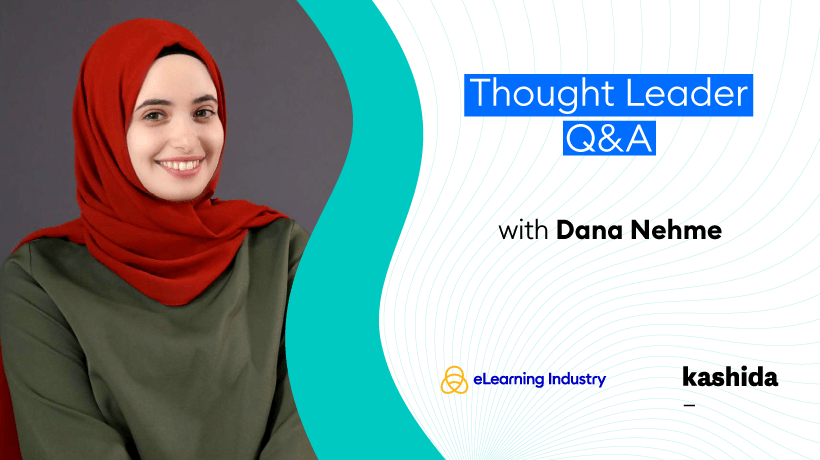Discussing New Modalities Of Content Consumption That Drive Learner Engagement
Dana Nehme is the Senior Learning Experience Designer at Kashida, who has experience in analyzing educational needs and crafting effective curricula. She has a solid background in Instructional Design principles that enable her to create engaging learning experiences tailored to diverse audiences. Today, she speaks with us about designing custom L&D that empowers organizations to upskill and reskill their teams through human-centered, engaging, and impact-driven content.
What is one of the most significant challenges that organizations face today regarding upskilling and reskilling in the world of Gen Z?
One of the biggest challenges organizations face today is aligning learning speed with the fast-evolving expectations and attention spans of Gen Z learners. It’s not just about keeping up with technological updates; it’s about designing experiences that fit their digital habits and emotional drivers. Research shows Gen Z learners expect digital experiences that reflect the fluidity of social media: short, visual, and participatory. Gen Z expects learning to be on-demand, personalized, and meaningful, not a one-size-fits-all solution.
They seek purpose, interactivity, and community, and organizations that fail to tap into these motivators risk disengagement. We see this play out often: many young professionals bypass long, static courses and instead head to YouTube or TikTok for instant, visual, and peer-driven learning. It’s a clear signal that learners want learning experiences that match the pace and rhythm of their lives. So, the challenge isn’t only “rapid tech updates”; it’s about keeping learning human, relevant, and continuous in a world where information moves faster than structured training cycles. Forward-thinking organizations are responding by offering learning in shorter cycles, sometimes even through gamified microbursts or interactive challenges, to keep pace with this need for immediacy.
Kashida’s approach focuses on new and innovative modalities of content consumption. What is the role of microlearning, gamification, and mobile-first experiences in sustaining learner engagement?
At Kashida, we always start with people, not platforms. Our human-centered approach means we design learning experiences around the learner’s real needs—not around trends. Before choosing a format like microlearning, gamification, or mobile-first design, we first understand how the learner thinks, feels, and engages with content. Once we do, we use what truly drives results. We’ve shared more about this in our blog on designing engaging eLearning programs, but here’s a quick look at a few of the techniques we rely on and why they work.
Microlearning delivers knowledge in short, focused bursts that fit naturally into busy lives. Gamification adds the emotional layer; it transforms learning from a passive process into a challenge-based journey. We use badges, progress indicators, leaderboards, and story-driven missions to make learners feel a sense of growth and accomplishment.
And with mobile-first experiences, we meet learners exactly where they are: on their phones, constantly connected, and seeking instant, meaningful engagement. Our designs are responsive, accessible, intuitive, and bite-sized, helping learning flow naturally into daily life. These approaches make engagement sustainable rather than situational.
Can you share some real-world insights from Kashida’s internal programs, including the internship and onboarding experiences?
Our internal programs reflect our learning philosophy in action.
In the internship program, we bridge theory and practice early on. Interns often tell us they love the hands-on nature of their learning, moving from conceptual understanding to real-world application. Each day brings micro-tasks that build toward a bigger goal, and they appreciate the constant challenge and feedback loop.
For the onboarding experience, we’ve gamified the journey to make it both welcoming and rewarding. New hires progress through modules that gradually increase their “Kashider level”—you start as 0% Kashider and end the program at 100%. They explore the Employee Handbook through a scavenger hunt activity, turning what’s often static content into a discovery experience.
We also encourage new team members to book short meetings with colleagues to discuss each module, turning learning into a social experience. This structure not only fosters engagement but also strengthens team connection and culture from day one.
Is there a recent development project, product launch, or another initiative our readers should know about?
We’re currently developing a gamified learning experience for the Salem Bin Mahfouz Foundation focused on Future Skills for youth, and it’s one of our most exciting projects yet. The experience goes beyond a course: it’s a full platform with programs that combine edutainment and challenge-based learning.
Learners progress through mini-games, missions, and leaderboards, tracking their progress against peers. What makes it stand out is how it invites learners to apply knowledge in real life by uploading short videos, comic strips, or visual collages to share their findings and reflections, echoing Gen Z’s natural social media behaviors.
The story world is built around social media itself, making it familiar, playful, and deeply relevant to how young people consume and express information today.
What youth-focused programs has Kashida worked on to help younger learners build financial literacy, cybersecurity, anti-corruption, and future skills?
Kashida has developed several youth-focused programs that blend learning with interactivity and storytelling.
For instance, we collaborated with UNDP and the National Institute for Governance and Sustainable Development (NIGSD) and created a gamified interactive game for teens in Egypt that teaches integrity and anti-corruption through scenario-based storytelling. Learners choose avatars and navigate real-life-inspired dilemmas, making choices that shape their journey and awareness of corruption concepts and mechanisms to mitigate risks and find solutions.
In financial literacy, we supported Riyali Foundation to shift their Ajyal program from face-to-face delivery to a fully online, inquiry-based design that kept learners, aged between 12 and 16, hooked across devices. The experience offered short interactive modules, peer video reflections, and mobile-friendly delivery.
As for our Safe Space project that aims at protecting children by promoting a culture of cyber safety and security in Qatar and the Arab world, we helped young people, caregivers, and educators engage with over 450 microlearning assets through story-driven and visual formats. The experience mirrored how they already consume content: quick, visual, and story-driven.
Across all these programs, the thread is the same: learning that feels alive, relevant, and self-driven; not instructional, but inspirational.
Wrapping Up
Thanks to Dana Nehme for sharing her experience and insights with us. You can also check out Kashida’s website to learn more about their award-winning solutions that are trusted by companies around the globe.
Last but certainly not least, we’d like to congratulate Kashida for earning a spot on our Top Content Providers to Enhance Your Employee Engagement Strategies list.




